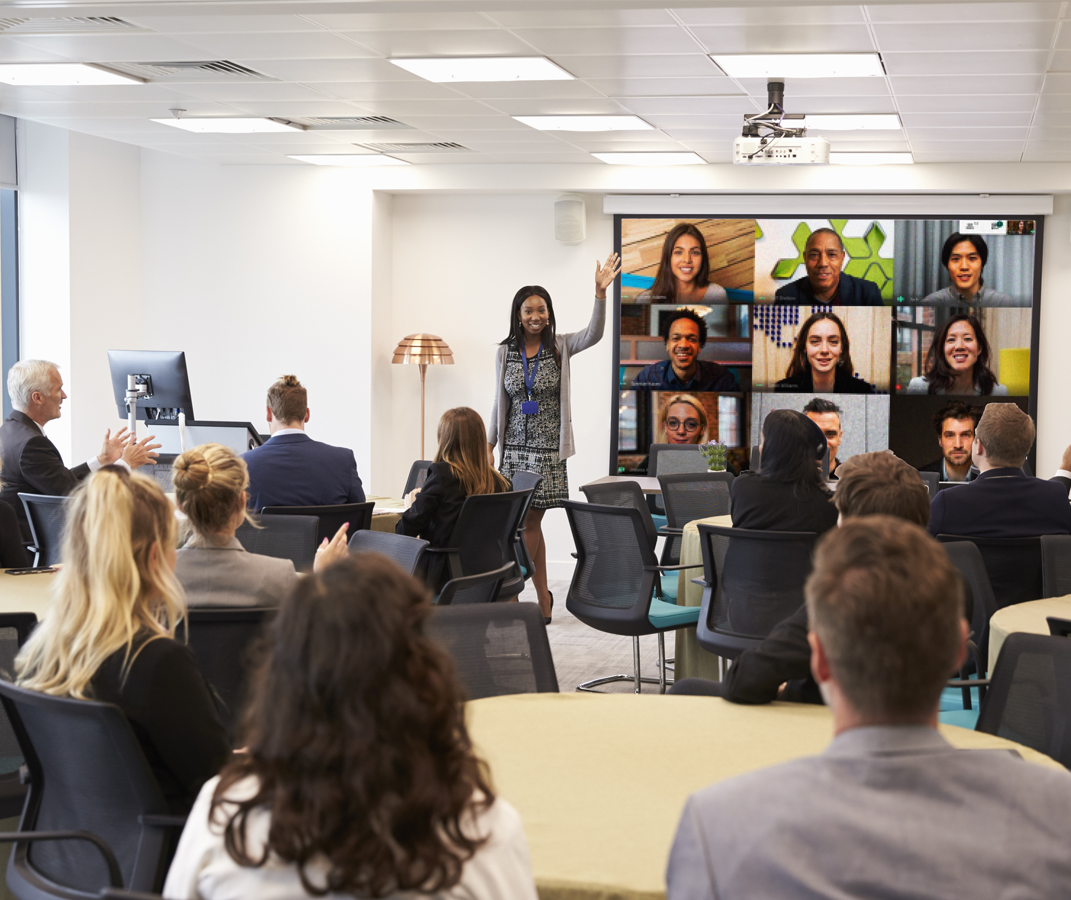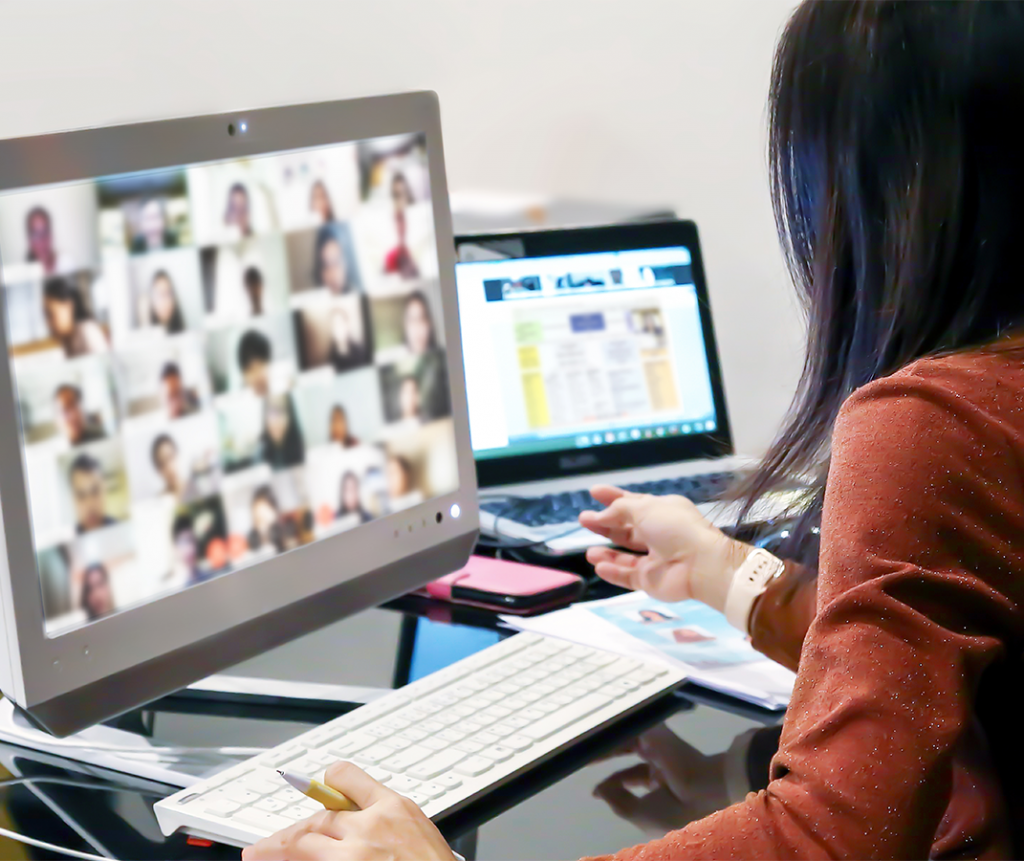Imagine you’re organizing an in-person learning event for a group of 30 senior leaders. You’ve spent weeks getting the details just right. It’s the first time this group will be getting together in over two years, and you can’t wait for two days of interactive, collaborative learning.
And then, the calls start to come in. One week out from the event, the head of marketing tells you there is a case of Covid-19 in her daughter’s classroom, and she will need to attend the session remotely to keep her in self-isolation. Then, three days before, two more calls come from sales leaders who need to travel to meet with clients and will need to participate remotely.
In a matter of days, 10% of your group needs to attend remotely. More requests are sure to come in, and your team now needs to come up with a way to accommodate both in-person and remote learners on short notice.
This is the new reality. The question is no longer whether to deliver learning remote or in-person – but rather whether to be fully remote or to host a hybrid learning experience. By assuming all in-person events will need to accommodate remote participants – and planning accordingly – you can create learning experiences that are ready to adapt to whatever may come.
Hybrid is to Netflix as in-person is to Blockbuster
Hybrid learning events struggle to achieve their goals when they’re treated as an in-person experience first. But as many industries have learned the hard way when undergoing disruption, you can’t do what you’ve always done and expect the same results. Much as Blockbuster failed to recognize Netflix as a serious disruptor, learning organizations stand to fail by ignoring the importance and permanence of hybrid learning.
Much as Blockbuster failed to recognize Netflix as a serious disruptor, learning organizations stand to fail by ignoring the importance and permanence of hybrid learning.
When L&D professionals do as Blockbuster did and try to carry on with business as usual, the result is a poor experience. The overarching problem is the lack of interactivity between in-person and remote participants, resulting from poorly adapted technology and resources, limited opportunities for participants to connect with each other, and a failure of the event organizers and facilitators to understand participants ahead of time.
At the heart of solving these problems before they happen is a focus on creating a unified experience for all learners. Successful hybrid learning events do this by giving careful consideration to how technology is used, creating opportunities for participants to connect, and getting to know participants ahead of time. In delivering hybrid learning to our clients, we’ve observed some innovative practices that exemplify this philosophy.
Adapt technology to the human experience – not vice-versa
Inequality in hybrid learning environments often results when the human element is considered secondarily to technology. For example, remote participants suffer when their experience is made possible by a laptop placed near the front of the room. Thoughtful hybrid learning design considers the desired experience first and then uses technology to build quality and efficiency, creating a “one-classroom” model where all participants feel included and barriers to communication are removed.
Bring the online experience into the room
One of our clients, a major quick-service restaurant chain, added a screen at the front of the room displaying the online experience. This ensured everyone in the room, including the facilitator and participants, were constantly aware of the people who weren’t physically present.
Create a screen-friendly experience for online participants
In early 2020, our partners in the Full-Time MBA program at the Smith School of Business at Queen’s University found a way for remote learners to experience the class in the same way as the in-person cohort by hiring a full-time videographer. As the approach has proven successful, the program is now leveraging technology to deliver the experience more efficiently with an automated system.
As a low-cost alternative, the quick-service restaurant chain asked in-person participants to bring their laptops and join the online meeting, keeping their cameras on so remote participants could see faces and hear comments. An AV support team set up microphones at every table to ensure remote participants could hear discussions clearly and both the in-person and remote conversations were moderated. We like this approach enough that we’ve adopted it for our own hybrid staff meetings – with great success.
Have support to bridge the gap
The Smith MBA program addressed cross-medium communication challenges by placing a staff member in each classroom to act as a moderator, managing the incoming Zoom information and filtering it to the faculty to ensure the remote participation was managed efficiently.
Create opportunities for participants to connect with each other
What we know as we gain more experience through this hybrid world is that people are craving more opportunities to connect on both a personal and professional level with their colleagues – a part of the experience that’s often neglected for online participants.
At larger events, we’ve seen this solved with formalized “brain dates” in which participants have scheduled time to meet one-on-one or in a small group, and indicate their preference to meet live, online, or hybrid. Meetings can be on a subject relevant to the event or less-formal opportunities for networking.
Our team at Third Factor has addressed this by scheduling a regular meeting with cameras on to share from our learning experiences and connect about what’s happening at a personal and professional level. We don’t just stop there though, many of us set up informal coffee chats to reconnect with each other, have a laugh, and sometimes we actually have a coffee!
Understand the field before playing the game
In our 3×4 Coaching program, we teach that people can’t commit without having clarity on what’s expected and why it matters. Successful hybrid learning events require the organizers and facilitators to have clarity on who the participants are and what their needs are.
One of our favorite ways of building clarity comes from the legendary basketball coach Jack Donohue, who would ask: “what would you see,” and “what would you hear.” I.e., what would you see and hear if you were a remote participant having a positive, engaging experience?
The Smith MBA Program called this “understanding the field before playing the game.” The instructor got to know remote participants’ names and locations ahead of time, and was able to use that information to engage them – acknowledging them personally and asking questions of them throughout the session.
Keep your eyes wide open
As Albert Einstein said, “you can’t use an old map to explore a new world.” To execute successful hybrid learning events, learning & development teams need to recognize that the choice isn’t between remote and in-person learning; it’s between remote and hybrid.
Every in-person event will inevitably need to accommodate remote participants, at least in the near-future. To ensure your next learning event is successful, this shift in designing your learning experiences will require thoughtful planning to put the human experience ahead of technology, create opportunities for participants to connect with each other, and get to know your participants ahead of time so everyone can be included.





